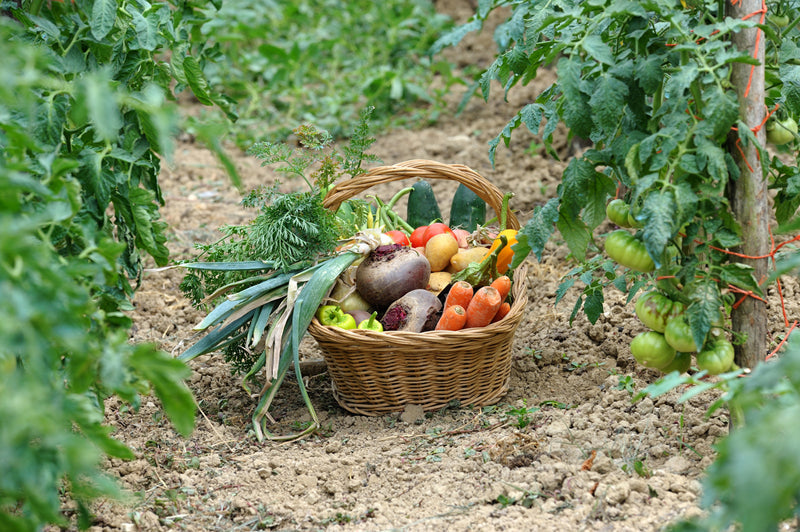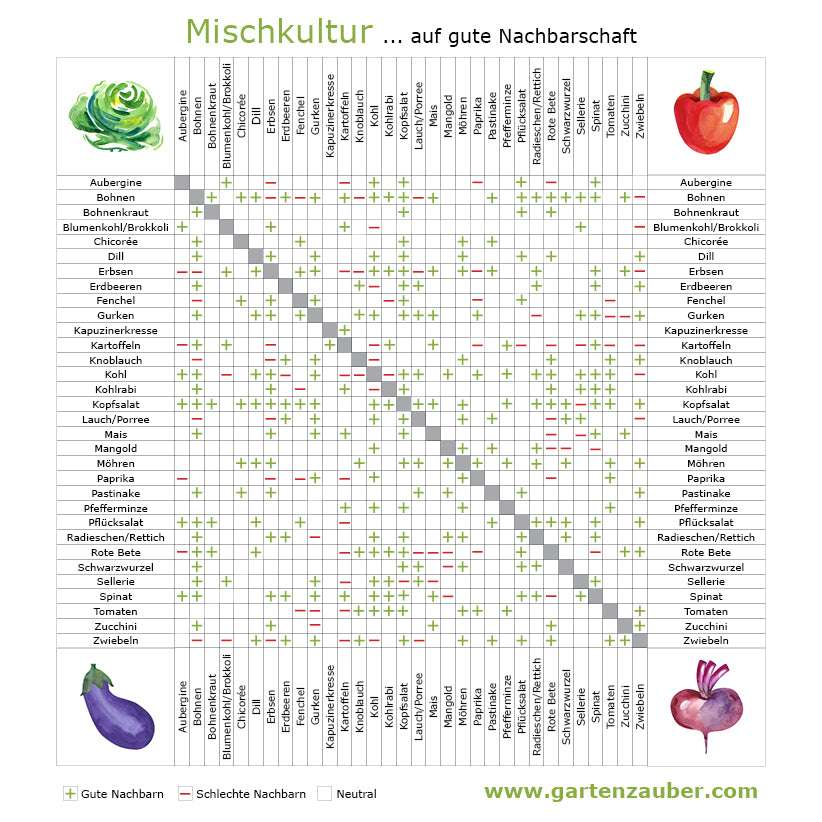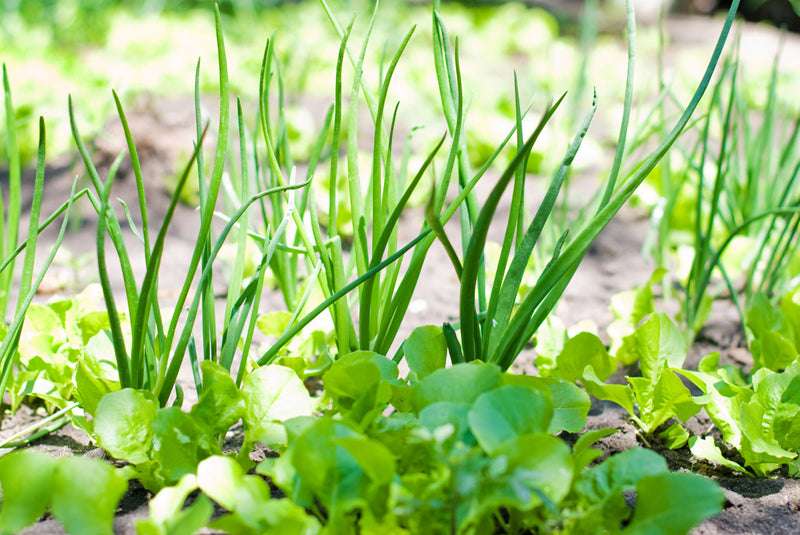Mixed culture – to good neighbors
What makes a good neighbor? A peaceful coexistence without conflict. When things go really well, neighbors even benefit from each other, for example through help or even consideration – of course, this also applies to the vegetable patch! With the right neighbors, plants thrive twice as well. Therefore, certain vegetables are deliberately planted together in mixed gardening. The healthier the plants are and the more carefully they are grown and cared for, the better the neighborhood functions.

Nature of things
Nature doesn't know monoculture; in meadows, flowers all grow colorfully alongside each other. Certain plant communities can be found, certainly not by chance, but rather intended by nature. This allows individual species to thrive under the best possible conditions. Nature shows us how it works, and in natural gardening, we try to imitate and utilize this secret as best as possible.
Advantages of mixed culture
Cultivating specific vegetable varieties in a single bed has many advantages over monoculture. First, of course, is the greater variety, since monoculture involves growing only a single vegetable variety over larger areas. Rotating the locations of individual vegetable crops also prevents soil fatigue and the spread of diseases. Good neighbors grow together and shade the bed; this reduces soil evaporation and almost completely eliminates weeds. In this "strong community," diseases and pests have less chance of spreading.
Mixed crops require less space and make optimal use of the available bed space. Especially in small gardens, bed space can be utilized more effectively by combining tall plants like kohlrabi with broad-growing leaf lettuce. Intercropping or interplanting can even increase the overall yield.
What do you have to consider?
A balanced combination of heavy feeders (e.g., potatoes, strawberries, beets, or lettuce), medium feeders (e.g., beans, peas, cucumbers, tomatoes, or peppers), and light feeders (e.g., cress, garden herbs), as well as deep-rooted vegetables (e.g., carrots or radishes) and shallow-rooted plants (e.g., onions or lamb's lettuce), ensures that the plants receive a balanced supply of nutrients from the soil. The plants do not interfere with each other, either above or below ground. Slender plants alternate with bushy plants. This creates almost "natural conditions" and a balanced microclimate. However, you must ensure that, in addition to sun, air, and healthy soil, plants always require sufficient spacing. The lower parts of the plant also always need sufficient light and air; only then will they grow vigorously and not become susceptible to pests. Fast-growing varieties such as radishes, lettuce, or cress thrive with slow-growing varieties such as tomatoes or cucumbers.
In every bed, a distinction is made between pre-crop, main crop, follow-on crop, and intermediate crop. The main crop remains in the bed the longest; the pre-crop (e.g., lettuce) will have already been harvested if the main crop (e.g., tomatoes) is planted earlier. Radishes, cress, or lettuce are ideal short-term intermediate crops; they can still be sown at the same time as the main crop or even later. However, the basic principle is that the intermediate crop must not interfere with the main crop under any circumstances. The follow-on crop, planted or sown shortly before the main crop is harvested, can later become an intermediate crop or even emerge as the main crop.
It's best to create a garden plan before the start of the gardening season, specifying the vegetables you want to plant. Using our companion planting table, you can easily combine the plant pairs for your beds.

Keep moving
It's best not to plant vegetables in the same bed where they were last year. This allows for optimal use of the soil's nutrients and prevents one-sided use of the soil. The health of the plants and the soil is maintained and promoted. Exceptions include strawberries, for example, which can remain in the same bed for three years. Tomatoes can also grow in the same bed for two to three years in a row.
Utilizing talents
Neighboring crops thrive when the plants don't compete for nutrients, improving yield and quality and potentially even repelling pests. Plants not only absorb substances from the soil, they also release them. These excreted scents can even repel pests from neighboring plants. This creates a mutual give-and-take: For example, the carrot fly absolutely cannot stand the smell of onions, so you can plant onions next to carrots.
- Garlic or herbs like savory and basil promote better health in their planting partners. Planted between strawberries, garlic has an antifungal effect and keeps the fruits and leaves healthy for longer. Beans are protected from the black bean aphid when planted with savory.
- Tagetes is great for all plants that suffer from root nematodes in the soil (e.g. tomatoes), as it eliminates them.
- Celery's smell repels cabbage pests and is therefore useful for cauliflower, Brussels sprouts, and white cabbage.
- Lettuce and kohlrabi also keep pests away from each other wonderfully.
- If the seeds are sown directly next to it, dill promotes the germination of many plants.
- Caraway has a positive effect on the taste of early potatoes when grown in mixed crops.
Which plant belongs to which family?
Knowledge of botanical relationships offers good guidance for vegetable gardeners. Vegetables from the same plant family should not be planted next to or one after the other in the same bed – or only with sufficient spatial separation. They have the same ancestors and therefore often have similar needs and not only require the same nutrients, they also suffer from the same pests. If the plants are only distantly related or not related at all, they get along perfectly. Some plants simply don't "get along." Potatoes and peas, for example, shouldn't be planted together in the same bed, and beans and garlic don't get along at all.
Umbelliferae:Fennel, carrots, parsley, celery, dill, chervil, coriander, parsnipsLamiaceae: Rosemary, basil, savory, sage, thyme, peppermint, lemon balmAsteraceae:Sugarloaf, endive, chicory, chamomileCruciferous plantsof the genus cabbage (Brassica): broccoli, cauliflower, green cabbage, kale, red cabbage, white cabbage, savoy cabbageCruciferous plantsof the genus Radish (Raphanus): radish, radishCucurbits:Cucumber, pumpkin, zucchini, melonsAlliums:Garlic, leek and all onionsNightshade plants:potatoes, peppers, tomatoes, chili peppersFabaceae:Beans, peas, lentilsGoosefoot plants:Spinach, beetroot, chardLiliaceae:Chives, garlic, onions, asparagus
TEXT: Victoria Wegner

Utilizing talents
Neighboring crops thrive when the plants don't compete for nutrients, improving yield and quality and potentially even repelling pests. Plants not only absorb substances from the soil, they also release them. These excreted scents can even repel pests from neighboring plants. This creates a mutual give-and-take: For example, the carrot fly absolutely cannot stand the smell of onions, so you can plant onions next to carrots.
Garlic or herbs like savory and basil promote better health in their planting partners. Planted between strawberries, garlic has an antifungal effect and keeps the fruits and leaves healthy for longer. Beans are protected from the black bean aphid when planted with savory.
Tagetes is great for all plants that suffer from root nematodes in the soil (e.g. tomatoes), as it eliminates them.
Celery's smell repels cabbage pests and is therefore useful for cauliflower, Brussels sprouts, and white cabbage.
Lettuce and kohlrabi also keep pests away from each other wonderfully.
If the seeds are sown directly next to it, dill promotes the germination of many plants.
Caraway has a positive effect on the taste of early potatoes when grown in mixed crops.
Which plant belongs to which family?
Knowledge of botanical relationships offers good guidance for vegetable gardeners. Vegetables from the same plant family should not be planted next to or one after the other in the same bed – or only with sufficient spatial separation. They have the same ancestors and therefore often have similar needs and not only require the same nutrients, they also suffer from the same pests. If the plants are only distantly related or not related at all, they get along perfectly. Some plants simply don't "get along." Potatoes and peas, for example, shouldn't be planted together in the same bed, and beans and garlic don't get along at all.
Umbelliferae:Fennel, carrots, parsley, celery, dill, chervil, coriander, parsnips
Lamiaceae: Rosemary, basil, savory, sage, thyme, peppermint, lemon balm
Asteraceae:Sugarloaf, endive, chicory, chamomile
Cruciferous plantsof the genus cabbage (Brassica): broccoli, cauliflower, green cabbage, kale, red cabbage, white cabbage, savoy cabbage
Cruciferous plantsof the genus Radish (Raphanus): radish, radish
Cucurbits:Cucumber, pumpkin, zucchini, melons
Alliums:Garlic, leek and all onions
Nightshade plants:potatoes, peppers, tomatoes, chili peppers
Fabaceae:Beans, peas, lentils
Goosefoot plants:Spinach, beetroot, chard
Liliaceae:Chives, garlic, onions, asparagus
TEXT: Victoria Wegner








































































































